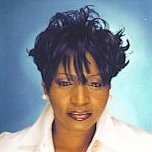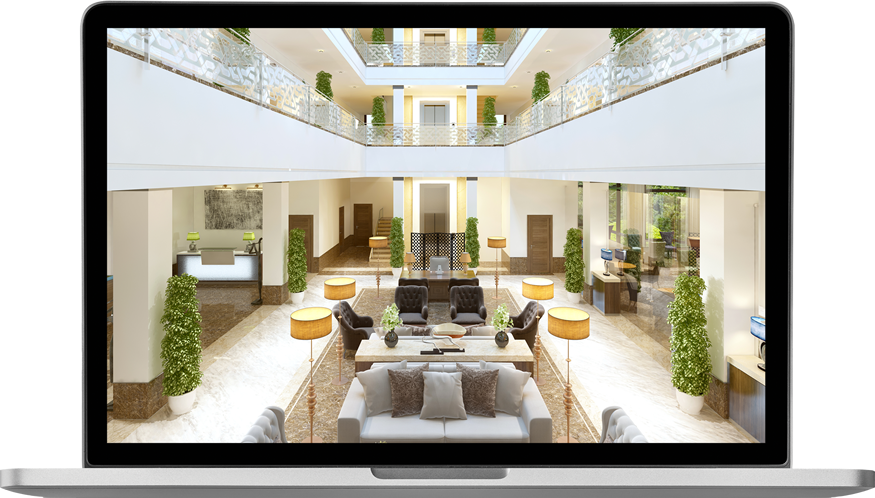With the exception of your home page, your accommodations page is the most important page on your website. As the bottom of your conversion funnel, an optimized accommodations page is essential to increase room revenue for your hotel. If you are looking to increase your rooms revenue, design all on-page elements for conversions. Then, do everything within your power to get potential guests to that page; after all, what good is an optimized rooms page if nobody sees it?
With this post, we will take a deep dive into what makes a great accommodations page. We will explore best practices for conversion rate optimization, delve into the unique SEO goals for this type of page, and help you make the most of the all-important accommodations page.
Conversion Rate Optimization for Rooms Pages
Your deft and savvy digital marketing team goes to great lengths to build awareness for your hotel, drive traffic to your website, and funnel potential guests to your all-important accommodations page. So when a visitor finally arrives on your rooms page, you better deliver an exceptional experience that showcases your property in the best possible fashion. Otherwise, you will send potential bookings into the beds of your competitors.
To ensure your marketing efforts culminate with revenue instead of a whimper, optimize each on-page element for conversion. Tell your story, show your amenities, and create a seamless booking experience.
With a strategically optimized rooms page, your website will act as the bottom of your sales funnel, drive check rate clicks, and increase the ROI of your digital marketing efforts. Take a look at Blue Magnet’s CRO best practices to maximize the value of your hotel’s website.
Get Great Photography
If you do just one thing to market your guest rooms, get great photography. Nothing will showcase the look, feel, and style of your property like high-resolution, thoughtfully-composed images. On the day of the shoot, pay attention to the lighting and details, show everything the room has to offer from different angles and distances, and recreate the experience of staying at your hotel. Photos with less than pristine rooms, weird filters, or sloppy composition can distract users and detract from your page’s potential to convert.
Once you have your stellar photography, capture the attention of your potential guests by creating a masthead with your most enticing image. It should be crisp, properly cropped, and sized appropriately to create a seamless, frictionless user experience. Just make sure your masthead image height is not too high; you want your content accessible at a glance when a user lands on your page.
In the screenshot below, the first sees a crisp, rooms image followed by the page’s H1 tag, and glimpse of the page’s primary content:
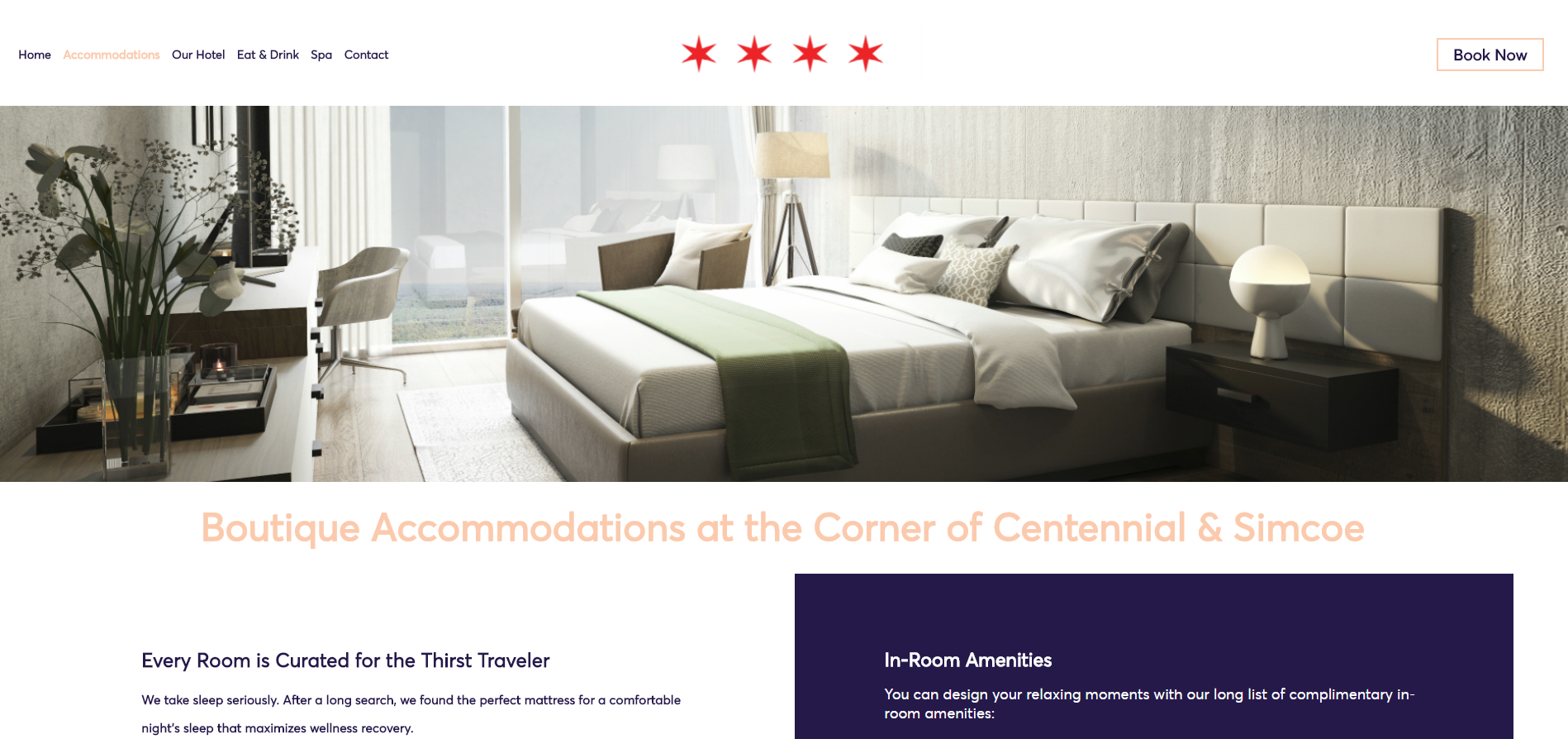
Include images throughout the page as well, but do not go overboard. Excessive scrolling, additional load time, and less emphasis on your calls to action can potentially detract from the page’s conversion potential. Keep your design simple and clean; one image per room description works best, but additional images are appropriate when paired with a tasteful design.
Tell a Story, Sell the Experience
Speak directly to the reader, be specific, and tell a story with your copy. Reference specific in-room amenities and write creatively to replicate your guest room experience for travelers. Make the visitors on your rooms page feel like they are already at your hotel.
Will guests drift to sleep to the hypnotic sounds of the crashing surf? Do your suites have full in-room kitchens for families to prepare breakfast before heading to the local amusement park? Do your rooms have multiple sinks and mirrors so that guests can simultaneously get ready for the day?
Words matter. Use them to set the stage and introduce a hotel experience worth booking.
Include Clear, Strong Calls to Action
Now that you have told your story and recreated the atmosphere of your hotel, tell your potential guests exactly what they need to do to reserve a room. Use strong action verbs, speak directly to your reader, and provide visitors with various ways to book.
Include Different Types of Booking Links
Choice paralysis is real, and it is important to give the option of not committing a specific room type. While you should include booking links to each individual room type, you should also give potential guests a general reservation option, where they can compare pricing and availability in the booking engine. If a visitor feels the need to commit to one specific room type during his or her first interaction with your rooms page, the user may bounce, and you may lose that room night.

Make Your CTAs Clear and Specific
Your calls to action should also be specific. When a user clicks your booking button, he or she should know exactly where the link goes. For example, if a guest clicks to book the Presidential Suite, your CTA should be something like “Reserve the Presidential Suite” instead of a generic “Book Now” for each room type. By customizing your calls to action, you will see stronger click through rates to your booking engine.
Below you’ll find a room-specific CTA for the Vallejo Hotel’s Double Daisy Suite:
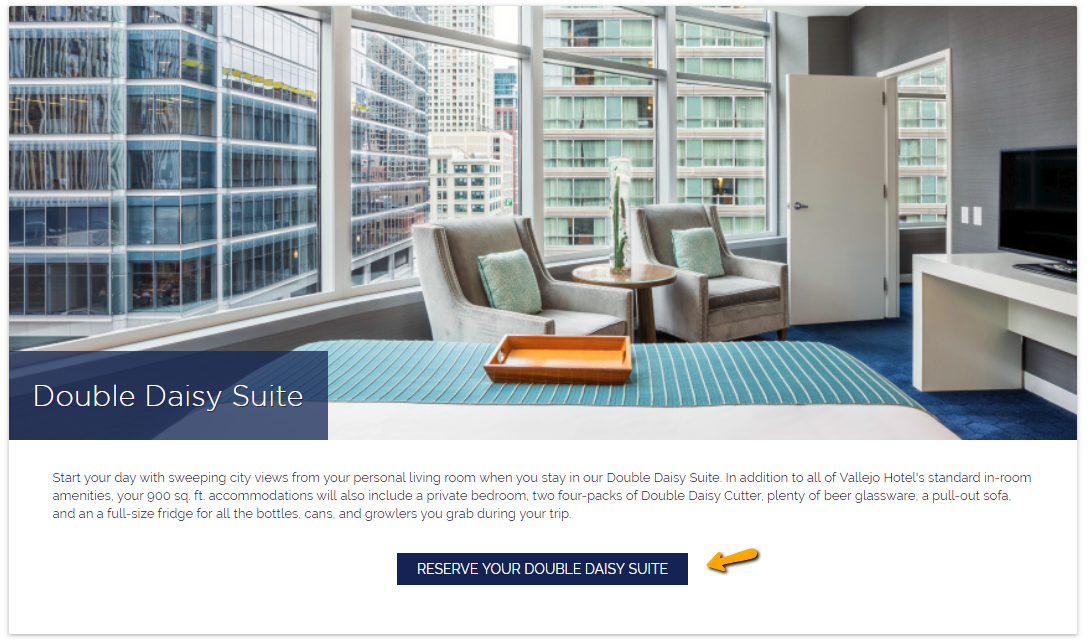
Answer Any and All Questions Before They’re Asked
Each visitor has unique travel criteria, and your rooms page should tell potential guests exactly what to expect from your accommodations. Your copy and imagery should evoke emotion by recreating the guest experience, but you also need to clearly and succinctly outline your in-room amenities. For some travelers, adjoining rooms with access to rollaway beds are a must; for others, a mini-fridge and balcony are essential. By telling potential guests on your rooms page what to expect from your hotel and how many guests each room type sleeps, you will better satisfy user intent and minimize the urge for visitors to bounce out of your booking funnel in pursuit of basic information.
Amenities Worksheet
When you are mired in the day-to-day of managing a hotel, you may cease to even notice some of the base-level features that make your guests’ experiences exceptional. Complimentary amenities that may seem obvious to you may be the final impetus a traveler may need to pull stay with you.
To ensure you provide every bit of relevant information to drive conversions, keep an amenities checklist handy for your marketing department. With the help of this document, you can answer the burning questions that travelers have in the booking process.
How many guests does the Deluxe King Room sleep? Do you offer connecting rooms? Do all rooms have views? Can I stream my shows on my in-room TV? Download this amenities worksheet to make sure you have not missed any crucial details when it is time to optimize your rooms page.
Avoid Redundant Content
While outlining your in-room amenities is crucial to the success of your rooms page, avoid repetitive content. Do all of your rooms have free WiFi, flat-screen TVs, microwaves, and the same bath products? Instead of reiterating this in each room description, include a list of in-room amenities common to all rooms at the top of your page.
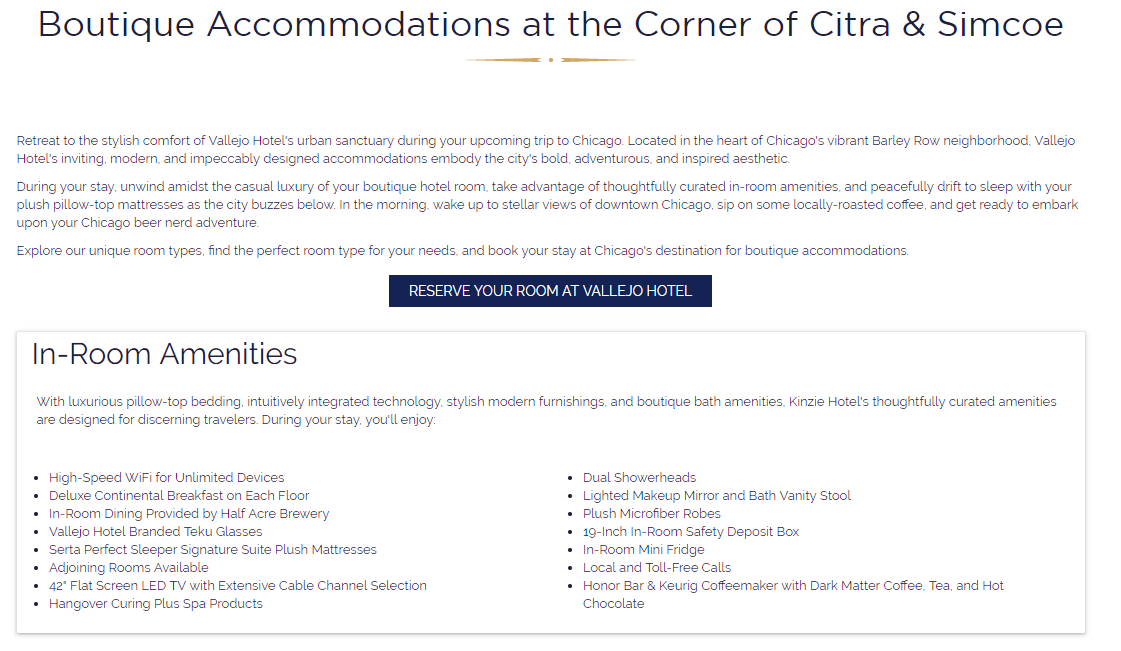
If certain rooms types have unique amenities, incorporate that information into the relevant room description. Use these special room features to replicate the experience of staying at the hotel and better differentiate your individual room types.
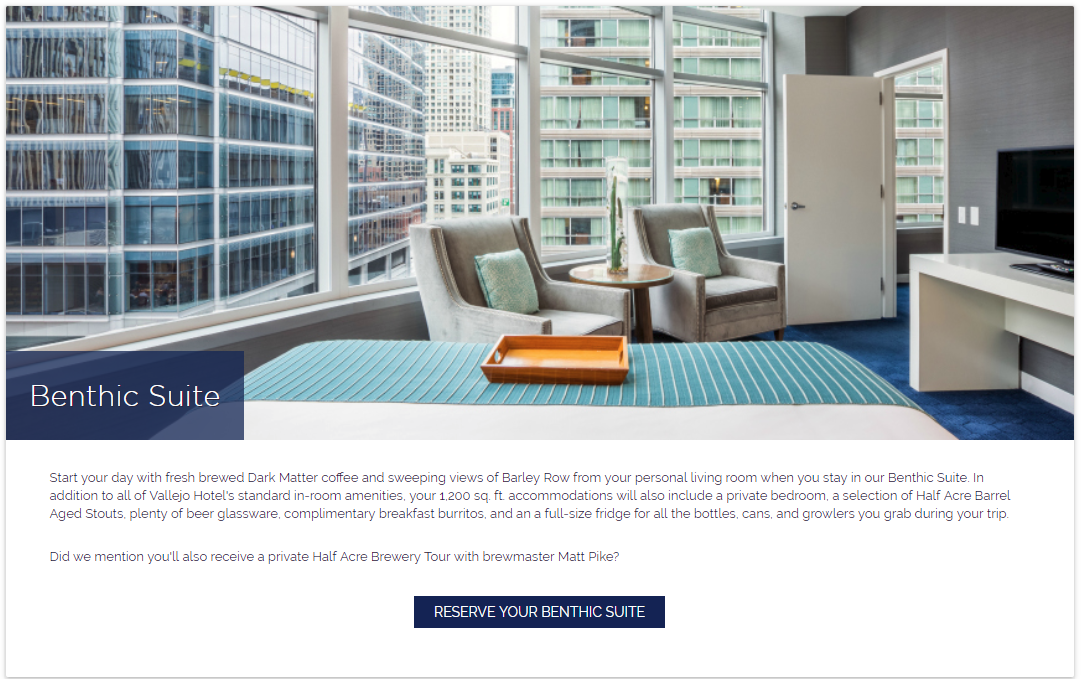
Not only will this give you more space to showcase what makes each of your rooms truly unique, it will help your content feel fresh, curated, and personalized; repetitive lists feel templated and automated and ultimately distract from your primary goal of driving bookings.
Eliminate Friction in the Sales Process
To make your rooms page as effective as possible, eliminate all friction and distraction from the sales process. Not unlike avoiding redundancy, removing non-essential links and content will create a smoother, more efficient, and and more clearly-outlined conversion process. After all, you’ve worked hard to get potential guests to the bottom of your sales funnel, and links to your awareness and consideration pages will create roadblocks on the booking path you so meticulously created.
Common sources of friction on accommodations pages include:
- Prominently displayed links to social channels
- External links to awards, review sites, or local attractions
- Internal links to meeting, dining, local area, and other non-action pages
- Sidebars that do not contribute to your room reservation goals
- Overuse of interactive elements that distance the visitor from the rooms page experience
- Broken booking links
- Repetitive or poorly written content
Routinely Test Your Booking Links
This should go without saying, but you should be running quality assurance testing on your booking links on a regular basis. If your visitors encounter any problems moving into your booking engine, you will create confusion and friction in the reservation process. On a weekly basis, manually test each of your booking links to ensure everything is working properly; by manually testing your booking links, you can uncover issues that your Google Analytics data may not show.
Use Your Data to Drive Conversions
Harness the power of analytics to strategically organize the content on your accommodations page. Take a look at which room types drive the most revenue for your hotel and which room types earn the most clicks on your rooms page and showcase your most popular guest rooms higher up on the page. By prominently promoting your “best sellers”, your accommodations page will more effectively drive reservations for your hotel.
Maintain a Safe, Speedy, and Technically-Sound Website
As any SEO will tell you, each content page on your website should be safe, crawlable, quick to load, and free of broken links. For your rooms page, however, these elements carry importance beyond site health and search engine optimization. As your website’s conversion-driven action page, any broken links or site speed issues will create a frustrating user experience, introduce friction into your sales funnel, and lay the groundwork for a potential guest to bounce to the website of a competitor.
By maintaining a technically healthy rooms page, you will be able to create a more seamless and effective UX that evokes your on-property atmosphere and yields bookings for your hotel.
Creating Conversion Funnels to Drive Bookings
Now that you have created a compelling, effective, and conversion-optimized page with a strong potential to drive reservations, you need to get it in front of the potential guests that landed on your website. To do this, create a clear conversion path for prospective guests with strategic navigation and internal linking structures.
Clear, Concise Navigation
Your rooms content should be easily visible in your main navigation. Since we read from left to right and top to bottom, place your accommodations tab at the far left of your desktop nav and at the top of your mobile navigation. This will facilitate a seamless user experience for visitors in your conversion funnel.
Your navigation should also be clearly labeled. Do not get cutesy and clever. While navigation labels like “sleep”, “stay”, “rest”, and brand-specific language may complement your hotel’s identity, clearly marking your rooms page will reduce friction in your funnel and frustration among visitors. “Rooms”, “Suites”, “Accommodations”, and other clear descriptors work best.
Strategic Internal Linking
When potential guests in the PLANNING or BOOKING stage of travel lands on your site, your job is to guide them to your rooms page. A strategic internal linking strategy will set a curated trajectory for visitors through your site to your rooms content.
Homepage
Most people will enter your website on your homepage, which makes it the most important place to initiate your conversion funnel. On your homepage, include a prominent, visible, and enticing showcase of your rooms with a link to your accommodations page. This will put guests in the BOOKING stage of travel on your primary action page and help sell your unique hotel experience in the best possible light for visitors in the DREAMING and PLANNING stages of travel that may return to your site at a later date.
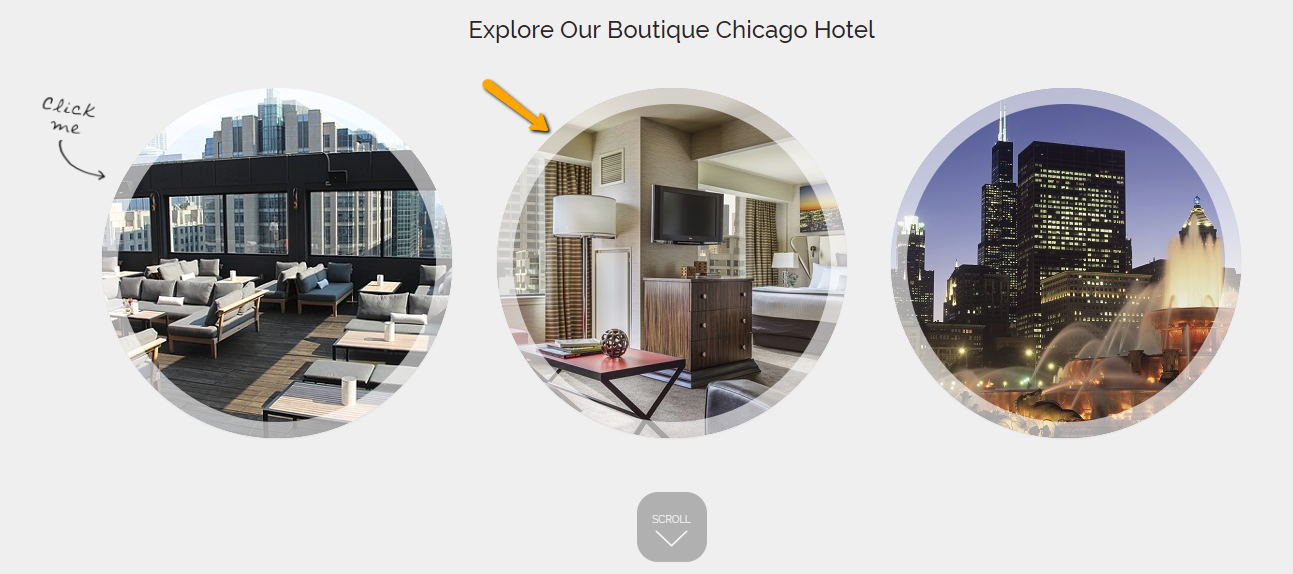

Internal Pages
Use your consideration pages to guide potential guests to your rooms page. You built your Pet Friendly, Family Friendly, and Local Attractions pages to target travelers with very specific criteria. To make these pages most effective, pave a conversion clear path with internal links, accommodations content, and strategic sidebar placements.
For example, if a guest types in “hotels near half acre brewery” and lands on your Half Acre page, you have earned a highly qualified lead. Your epic Half Acre and beer-nerd-friendly amenities content will set a great tone for your niche visitor, and strategically placed internal links will move him or her further into down conversion path.
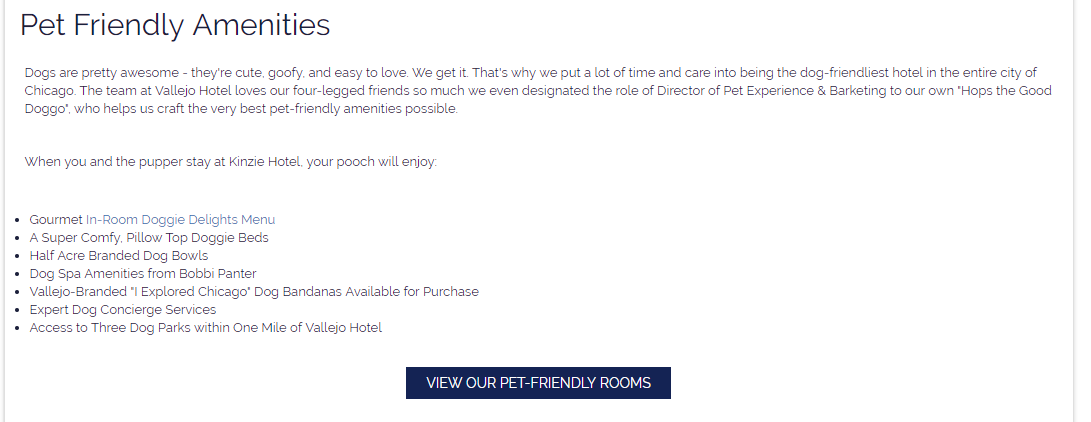
Even More Fun with Funnels
Want to learn more about building search and conversion optimized funnels into your hotel website? Check out Blue Magnet’s best practices for creating navigation structures and conversion funnels that target potential guests in different stages of travel.
SEO Best Practices for Accommodations Pages
While your conversion funnel will move guests already on your site to your conversion-optimized rooms page, a strong SEO strategy will drive traffic from search engines directly to your accommodations content. As one of your hotel website’s primary action pages, your accommodations page should target guests in the PLANNING and BOOKING stages of travel. By doing this, you will increase the quality and quantity of traffic to your rooms content, which means more revenue for your hotel.
Target Guests in the BOOKING Stage of Travel
After tireless deliberation and comparison shopping, a prospective guest has added your hotel to his or her shortlist of top contenders. To best target people in the BOOKING stage of travel, optimize your rooms page for branded search.
When a prospective guest types your hotel name in the search bar, you want your conversion-optimized rooms page to appear in the SERPs for this highly valuable query. Naturally, your index page will appear at the top of the SERP and in the knowledge graph, but sitelinks provide a unique opportunity to funnel that searcher to your curated, booking-focused content.
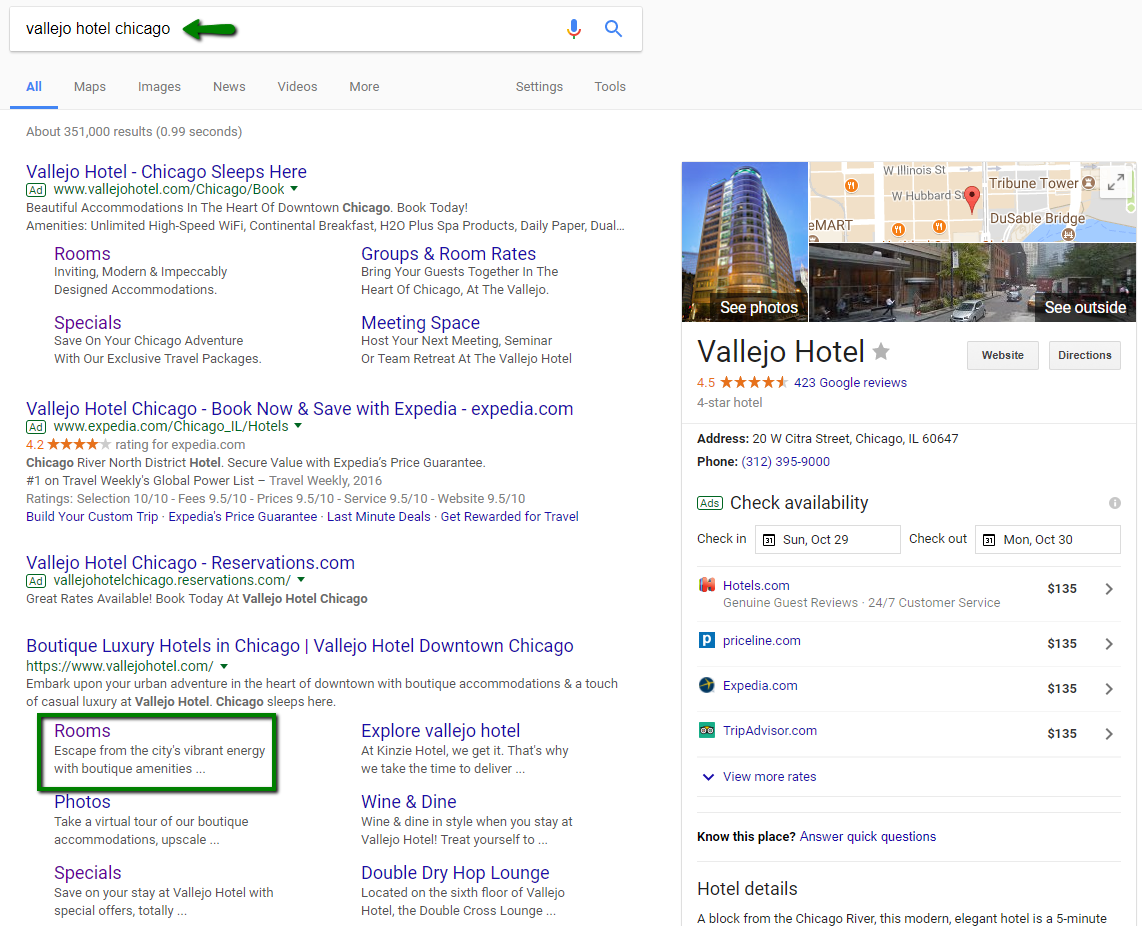
Research shows sitelinks can increase a page’s click-through rate by 64%, and having your accommodations page in the sitelinks puts you in a prime position drive traffic directly the bottom of your sales funnel.
How To Get Your Rooms Page to Appear in Google’s Sitelinks
Google algorithmically determines which sitelinks will appear on the SERP for your website, but you can influence which pages will appear.
- First, your site should rank at the top of the first SERP for branded keywords. To facilitate this, make sure your site is safe, healthy, technically sound, optimized for search, and includes the relevant schema markup.
- A clear, concise site hierarchy will also help your rooms page appear in Google’s sitelinks. Make sure your rooms page is clearly labeled and easily accessible in your main navigation.
- Internal links to your accommodations page will also facilitate sitelink real estate for your rooms content. By linking to your rooms page, you tell Google that it is an integral page to your website and business.
- Check the Search Analytics report in Google Search Console to see if your website is earning impressions for these long tail keywords. If your page is earning impressions for highly-searched keywords like “chicago hotel rooms with skyline views” and your accommodations fit the description, you can tailor your keyword targeting accordingly.
- Log in to your preferred SEO tool to see if any topics on your list have search volume. If your property is located on the border of two neighborhood – let’s call them Logan Square and Avondale – and you notice Logan Square has triple the search volume with equal SERP competition, optimize your keyword strategy to drive the most consideration traffic.
- After you identified a high-potential, long tail keyword opportunity, optimize your on-page content accordingly. Update your title tag, meta description, H1 tag, alt text, and appropriate copy to support your pivot towards a long tail keyword.
- Optimize each component your accommodations page for conversion
- Create a strategic sales funnel throughout your website
- Drive traffic to the bottom of your sales funnel through branded and non-branded search
Target Guests in the PLANNING Stage of Travel
Beyond appearing in the sitelinks for branded searches, your rooms page should also target guests in the PLANNING stage of travel. By ranking for high-value, highly-relevant, long tail keywords, your rooms page will drive traffic from potential guests that are looking for something very specific out of a hotel.
People in the PLANNING stage of travel typically have dates and a destination in mind for their upcoming trips but are still sorting out the concrete logistics. In the PLANNING stage, potential guests evaluate hotels based on their services, amenities, and location. Can I bring my pet? Does this hotel have adjoining suites for my family? Is the hotel in a vibrant neighborhood with awesome breweries and gastropubs?
Identifying Long Tail Keywords to Target
First, evaluate what makes your hotel rooms unique in your market. Are your suites designed for extended stays? Do your rooms have hot tubs? Is your hotel located in (or near) a trendy, up-and-coming neighborhood? Make a list, then turn to the data.
Once you have determined your accommodations’ best selling points:
Don’t Oversell Your Hotel for the Sake of the Long Tail Keyword
If you do identify a strong, relevant long tail opportunity, pursue it. However, if your keyword pivoting requires you to adjust your content to the point where it does not 100% accurately represent your hotel, do not pursue that topic. Mixed and unclear representations of your hotel create confusion, doubt, and anxiety among visitors, which will ultimately harm your conversion rate.
For example, if your hotel is located in a suburb fifteen miles from the city, do not pursue Chicago hotel keywords. You will create a muddied user experience for potential guests and your page will have little to no potential to rank.
Take Your Rooms Page to the Next Level
Rooms Page Worksheet
Improve your hotel’s weddings page. Download Blue Magnet’s Weddings Page Worksheet Today! ![]()
Download
The way you market your accommodations page is crucial to your website’s ability to drive rooms revenue for your hotel. To increase room nights at your hotel:
Keeping your website optimized for conversions is an ongoing process that requires strategy, attention, and the management of lots of moving parts. If you’d like some expert assistance driving room nights through your website, get in touch with Blue Magnet’s trusted marketing team.
Prefer to stick with DIY hotel marketing? Sign up for the Blue Magnet Newsletter for more insider knowledge from the industry’s foremost digital marketers.



